To date, a standardized return to work (RTW) best practice model does not yet exist. This is in part because the pandemic, caused by a novel pathogen (SARS-CoV-2), has impacted the world like no other global crisis inclusive of previous pandemics. This highly transmissible contagion has not followed the traditional linear pandemic wave as was witnessed with the Spanish Flu or H1N1:
Rather, the COVID-19 pandemic is best illustrated in a nonconventional circular graphic:
ACTUAL (GLOBAL) COVID-19 CYCLE
Global corporate medical directors (CMD’s), in every sector, are the ones usually tasked with coordinating and choreographing return to work (RTW) campaigns within their respective organizations. ALL report directly/indirectly to the C-suite who are concerned that the pandemic continues to (negatively) impact organizational productivity. Shy of a mandate to employees, RTW is in most cases thought to be in the best interest of the entire corporate ecosystem. With limited precedent or guidelines, many CMD’s are struggling to create their own RTW protocols. Any protocol cannot compromise the health and safety of their workforce. The “Council” recognizes that any RTW campaign is complex and to be successful it must seamlessly integrate screening/testing, tracking/tracing, and vaccinations. Understanding these three dimensions, which are not mutually exclusive, is critical to any RTW program.
This whitepaper is intended to support organizations successfully develop a Return to Work Program to safeguard the health and safety of their workforce and preserve business continuity.



